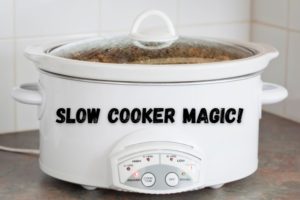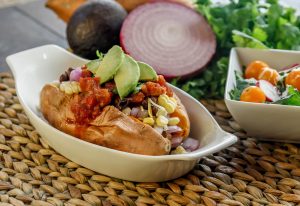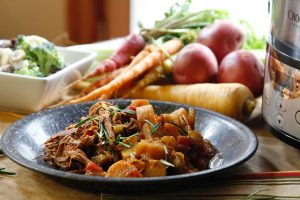 Imagine coming home and dinner is ready!
Imagine coming home and dinner is ready!
The slow cooker has been working all day long, so you can enjoy a delicious dinner as soon as you walk in the door.
Fix it and forget it…that’s the magic of the slow cooker!
We all probably own one, whether it has been your staple kitchen tool for years, or it’s collecting dust in your pantry. And, maybe you have a newer version where “slow cooker” is just one of its many capabilities.
The slow cooker is a great tool to use all year long, and it especially lends itself to delicious meals this time of year and for the next several months (chili and soup weather!). The slow cooker can be your best friend in the kitchen, and we want to share a few tips that can help you get the most of this magical kitchen tool!
The slow cooker became extremely popular in the early 1970s, when a lot of women were entering the workforce and wanted easy ways to prepare dinner. This was also the time when Rival trademarked the “Crock Pot.” Yes, if you have a Rival brand, it is called a “Crock Pot;” otherwise, it’s “just” a slow cooker! Their popularity grew even more when they became available with removable stoneware inserts to make clean-up even easier.
“That’s the way we’ve always done it…”
 There is some conflicting information and misperceptions out there when it comes to slow cookers.
There is some conflicting information and misperceptions out there when it comes to slow cookers.
For example, I was doing a local cooking demo and we got into a discussion about slow cookers. A couple of the class participants were saying, “I just can’t get anything to cook well in the slow cooker…it’s either too chewy, not done enough or just bland.” Several others in the class, myself included, were trying to figure out why they were not getting the same amazing results we were experiencing.
After racking our brains (we started to think they had defective crock pots!), we finally figured it out! They mentioned that, no matter what meat they put in their slow cooker, they were filling it 2/3 to 3/4 full of water. That’s it — that was the problem! Of course, that used to be the way people cooked with slow cookers (your mother or grandmother may have even taught you this). But we now know that less is more when it comes to liquid in the slow cooker!
Misconceptions like this one inspired us to put together some tips to hopefully make your slow cooker meals more successful!
Why use a slow cooker?
- Healthier! You rarely need to use additional oils and fats.
- Flavor factor! Because meats and sauces cooked in the slow cooker simmer in their own flavors, and not much is lost in evaporation, this can create some complex and awesome flavors!
- Save money! Part of the charm of the slow cooker is it breaks down the connective tissue in less expensive cuts of meat…and still produces tender “falling apart” meat and amazing flavorful meals.
- Huge time saver! Of course, the slow cooker can save you time by literally cooking a meal for you. Especially with meats, you can also cook enough that you can use the leftovers for multiple quick & easy, great-tasting meals throughout the week. An example is the Slow Cooker Balsamic Pork Tenderloin that quickly and easily turns into Encore Balsamic Pork & Pepper Quesadillas later in the week!
To brown or not to brown?
Sometimes, recipes tell you to brown the meat before adding it to the slow cooker. We have sometimes skipped this step because that is just one more thing to do. But this is also one of the secrets to success…especially when it comes to flavor! Keep in mind, this step is completely optional and not required, but it will add a richer, almost caramelized flavor (and a more attractive browned color) to your meats. So, if you have a few extra minutes…it’s worth it! And it’s always a good idea to brown ground meats before adding them to the slow cooker.
Caution with frozen?
 There is a lot of conflicting information on this topic! Food safety guidelines recommend you NOT put frozen meat in the slow cooker. WHAT?! Between my grandma, my mom, and me, we have been doing this for 30+ years and, to my knowledge, no one ever has gotten sick from the food being unsafely prepared.
There is a lot of conflicting information on this topic! Food safety guidelines recommend you NOT put frozen meat in the slow cooker. WHAT?! Between my grandma, my mom, and me, we have been doing this for 30+ years and, to my knowledge, no one ever has gotten sick from the food being unsafely prepared.
The argument is frozen meat stays in the “danger zone” temperature range of 40 degrees to 140 degrees for too long which can breed bacteria. Then, even though the slow cooker heats to 170 degrees or more on low, which is past the 165-degree bacteria-killing temperature, dead bacteria can still leave behind toxins. (Information you really wanted to know, right?!) Some of the newer slow cookers seem to cook at a higher heat, so the risk is reduced.
So, what is the answer? The safe answer is to safely thaw your meat before adding it to the slow cooker. This is where the planning comes in…as we know, the challenge is remembering to put the frozen meat in the refrigerator the day before. Each person will have to use their own judgment on this, but it’s worth being aware of the potential issue.
Less is more!
Covering your meat with liquid in the slow cooker is now considered “old school” and can result in bland, watery flavors. Instead, focus on seasoning the meat really well and add just 1/2 cup of water or broth. Very little evaporation occurs in the slow cooker so don’t worry about it “drying out.” Plus, most meats will release their own liquids, so you don’t have to add additional liquid. By using less liquid, you should definitely notice a more concentrated flavor!
A few more tips for slow cooker success:
 Size Matters! It is best to use the right size…many recipes (including those found on Eat REAL America) call for a 5-6 quart slow cooker. You want to fill the slow cooker 2/3 full — try not to overfill it!
Size Matters! It is best to use the right size…many recipes (including those found on Eat REAL America) call for a 5-6 quart slow cooker. You want to fill the slow cooker 2/3 full — try not to overfill it!
- Keep the lid on! Try to resist the urge to peek…at least within the first few hours. Each time you remove the lid, it adds about 20 minutes to the cooking time because it takes a while for the temperature to build back up inside the slow cooker.
- Prep the night before! Save yourself even more time in the morning and prep the slow cooker ingredients the night before. Then, in the morning, add everything to the slow cooker and you are good to go!
- Low is the way to go! Obviously, you can cook on high or low, but keep in mind, meat is more tender when cooked on low. The high setting is about half of the cooking time on low.
- Dairy at the end! If a slow cooker recipe calls for dairy or yogurt, it is best to add them at the end of the cooking time…in the last 15 minutes. If cooked too long, dairy can curdle and get chunky (appetizing, right?!).
- Dried herbs at the beginning; fresh herbs and greens at the end! Dried herbs are great to add at the beginning of the cooking process. Because these flavors can become diluted over several hours of cooking, it can be great to liven up the flavors by adding some fresh herbs during the last 15 minutes. If you put fresh herbs in too early, they can turn limp and brown.
- Skin, fat and bones! A rule of thumb is to remove the skin and excess fat from your meats but keep the bones. Cooking with the bones will help the meat stay tender and adds flavor.
- Keep it warm! If you are making a soup or a sauce or something you want to keep warm for an hour or two, the slow cooker is an ideal solution. Even if you are taking something to a gathering, you can prepare it and then transfer it to the slow cooker to keep it warm.
- Perfect pasta? Adding pasta in slow cooker recipes can be done but it’s best if added in the last hour. For other recipes, such as in slow cooker lasagna, it works best if the entire meal only cooks on low for 4 hours or so to avoid mushy pasta. These meals may not be ideal when you are wanting the slow cooker to make dinner while you are gone all day long.
For some fun and delicious ways to enjoy meals prepared in the slow cooker, check out these ideas:
 Slow Cooker Sweet Potatoes (then use them in flavor-loaded meals like the Southwest Stuffed Sweet Potato or the Stuffed Sweet Potato with Dates, Walnuts and Gorgonzola)
Slow Cooker Sweet Potatoes (then use them in flavor-loaded meals like the Southwest Stuffed Sweet Potato or the Stuffed Sweet Potato with Dates, Walnuts and Gorgonzola)- Seasoned Slow Cooker Chicken (allows you to easily make the Loaded Chicken Salad Sandwich, top the Southwest Stuffed Sweet Potatoes, Thai Pizza, plus many more!)
- Slow Cooker Vindaloo Chicken
- Slow Cooker Curried Lentils
- Slow Cooker Korean-Inspired Beef (you can use it in meals like Bi Bim Bop, tacos or even our Different Spin on Salisbury Steak)
 Slow Cooker Autumn Pork Tacos
Slow Cooker Autumn Pork Tacos- Slow Cooker Enchilada Soup Bar
- Slow Cooker Asian Chicken over Riced Cauliflower
- Crockpot Quinoa Pumpkin Chicken Stew
- Slow Cooker Curried Butternut Chili
- Slow Cooker Sweet and Savory Beef and Vegetables (this makes enough beef and vegetables for planned-overs for the Sweet and Savory Crustless Beef Pot Pie!)
- Slow Cooker BBQ Ribs
- Slow Cooker Pesto Chicken
- Slow Cooker Carne Asada Steak (you can turn the mouthwatering steak into tacos, nachos, lettuce wraps, stuffed sweet potato, topping for pizza…endless possibilities!)
- Slow Cooker Thai Pork Sandwiches
- Slow Cooker Caramelized Onions
- Slow Cooker Italian Beef Sandwiches
- Slow Cooker Mexican Chili (use the leftover chili for the Quick and Easy Loaded Sweet Potato with Mexican Chili)
- Crockpot Lasagna
Between these tips and even more Slow Cooker Magic meal ideas, we hope this inspires you to bust out your slow cooker to make mealtime easier…and turn REAL ingredients into super satisfying meals!
What is your favorite thing to do with your slow cooker?
 LEARN MORE ABOUT THE NAPKIN!
LEARN MORE ABOUT THE NAPKIN!



There are conflicting views on this but the conservative and safest view is to thaw your meat before adding it to the slow cooker. People with this view say that the meat can potentially stay in the danger zone too long and, even though the bacteria is killed when the meat cooks to 165 degrees or more, it can still leave harmful toxins behind. Others say it is probably safe to cook frozen chicken breasts in the slow cooker as long as you get it up to or above 165 degrees. Everyone has their own risk tolerance on this. We hope this helps!